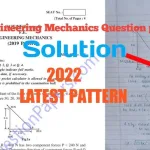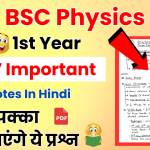Engineering mechanics is the foundation of many engineering disciplines. It covers concepts of force, motion, and equilibrium. Students preparing for exams often require practice with diverse questions. Below is a comprehensive set of questions and answers on various topics like statics, dynamics, kinematics, and more, to enhance understanding and application skills.
Statics
Question: What is the principle of transmissibility of forces?
Answer: The principle of transmissibility states that the external effect of a force on a rigid body remains unchanged if the force is applied at any other point along its line of action.
Question: Define equilibrium in mechanics.
Answer: Equilibrium occurs when the resultant of all forces and moments acting on a body is zero, causing it to be at rest or move with a constant velocity.
Question: What are the conditions for static equilibrium?
Answer: For a body to be in static equilibrium, the sum of all horizontal forces, vertical forces, and moments must be zero.
Question: Explain the concept of a free-body diagram.
Answer: A free-body diagram is a graphical representation of a system, showing all external forces and moments acting on it.
Question: What is the difference between a scalar and a vector quantity?
Answer: Scalars have only magnitude, such as mass or temperature, while vectors have both magnitude and direction, like force or velocity.
Question: Define the term centroid.
Answer: The centroid is the geometric center of an object or shape, where its area or volume can be considered concentrated.
Question: What is the moment of a force about a point?
Answer: The moment of a force about a point is the rotational effect of the force, calculated as the product of the force and its perpendicular distance from the point.
Question: How do you determine the resultant of two concurrent forces?
Answer: The resultant is determined using vector addition, typically employing the parallelogram law or trigonometric methods.
Question: What are the different types of supports in statics?
Answer: The main types of supports are fixed, roller, and pinned supports, each allowing specific movements or reactions.
Question: Explain the concept of a couple in mechanics.
Answer: A couple consists of two equal and opposite forces acting at a distance, creating pure rotation without translation.
Question: What is meant by the term “line of action of a force”?
Answer: The line of action of a force is the imaginary line along which the force acts, extending indefinitely in both directions.
Question: How do you calculate the center of gravity of a composite body?
Answer: The center of gravity is calculated by dividing the sum of the moments of individual parts about a reference point by the total weight.
Question: What is meant by a system of forces?
Answer: A system of forces refers to a group of forces acting on a body, which may be concurrent, parallel, or non-concurrent.
Question: Define Lami’s theorem.
Answer: Lami’s theorem states that if three forces acting at a point keep a body in equilibrium, the ratio of each force to the sine of the angle between the other two forces is constant.
Question: What are coplanar and non-coplanar forces?
Answer: Coplanar forces lie in the same plane, while non-coplanar forces do not.
Question: What is a concurrent force system?
Answer: In a concurrent force system, all forces meet at a single point.
Question: What is the difference between a rigid body and a deformable body?
Answer: A rigid body does not deform under force, while a deformable body changes shape or size when subjected to force.
Question: Explain the term “static determinacy.”
Answer: A structure is statically determinate if its equilibrium equations are sufficient to calculate all unknown reactions and internal forces.
Question: How is friction classified in mechanics?
Answer: Friction is classified as static friction, kinetic friction, and rolling friction, based on the motion between surfaces.
Dynamics
Question: Define kinematics and kinetics in mechanics.
Answer: Kinematics deals with the motion of bodies without considering forces, while kinetics examines the motion caused by forces.
Question: State Newton’s second law of motion.
Answer: Newton’s second law states that the acceleration of a body is directly proportional to the net force acting on it and inversely proportional to its mass.
Question: What is meant by uniform circular motion?
Answer: Uniform circular motion refers to movement along a circular path at a constant speed.
Question: Define impulse and momentum.
Answer: Impulse is the product of force and the time it acts, while momentum is the product of mass and velocity.
Question: Explain the work-energy theorem.
Answer: The work-energy theorem states that the work done by all forces acting on a body equals the change in its kinetic energy.
Question: What is meant by simple harmonic motion (SHM)?
Answer: SHM is periodic motion where the restoring force is proportional to displacement and acts opposite to it.
Question: Define angular velocity.
Answer: Angular velocity is the rate of change of angular displacement over time.
Question: What is centripetal force?
Answer: Centripetal force is the inward force required to keep an object moving in a circular path.
Question: Define the coefficient of restitution.
Answer: The coefficient of restitution is the ratio of the relative velocity of separation to the relative velocity of approach of two colliding bodies.
Question: Explain the law of conservation of momentum.
Answer: The law of conservation of momentum states that the total momentum of an isolated system remains constant if no external forces act on it.
Question: What is projectile motion?
Answer: Projectile motion is the motion of an object thrown into space under the influence of gravity, following a parabolic trajectory.
Question: Define torque.
Answer: Torque is the rotational effect of a force about an axis, calculated as the product of force and its perpendicular distance to the axis.
Question: What is relative velocity?
Answer: Relative velocity is the velocity of one body with respect to another.
Question: What is damping in mechanical systems?
Answer: Damping is the dissipation of energy in a vibrating system, reducing its amplitude over time.
Question: Define angular momentum.
Answer: Angular momentum is the rotational analog of linear momentum, given by the product of the moment of inertia and angular velocity.
Question: Explain the concept of moment of inertia.
Answer: Moment of inertia is the measure of a body’s resistance to angular acceleration, dependent on mass distribution about an axis.
Question: What are the types of mechanical vibrations?
Answer: Mechanical vibrations can be free, forced, damped, or undamped.
Question: What is the principle of work and energy?
Answer: This principle states that the work done by all forces on a body is equal to the change in its kinetic energy.
Question: What is Coriolis acceleration?
Answer: Coriolis acceleration is the additional acceleration observed in a rotating reference frame, caused by the rotation.
Engineering mechanics is a vital subject that builds the foundation for understanding physical systems in motion or at rest. This comprehensive set of questions ensures that concepts are clear and provides thorough preparation for academic and competitive examinations.
Latest Posts
- Step-by-step guide to download and apply for jee mains admit card 202
- Comprehensive 2025 government holidays and recruitment details for job seekers
- JEE Mains Admit Card 2025: Your Step-by-Step Guide to Downloading the Hall Ticket
- Everything You Need to Know About 2025 Government Holidays Recruitment
- Comprehensive Guide to rrb d group recruitment 2025 – Eligibility, Vacancies, and Application
- Detailed guide to nps trust recruitment 2025 vacancies, eligibility and apply process
- Comprehensive guide to hpcl recruitment 2025 notification, vacancies, and application process
- ignou bed admission 2025 complete recruitment guide with eligibility and process
- Comprehensive Guide to Indian Army Agniveer Recruitment 2025 Notification and Jobs
- Everything You Must Know About CBSE Board Exams 2025 Changes & New Rules






